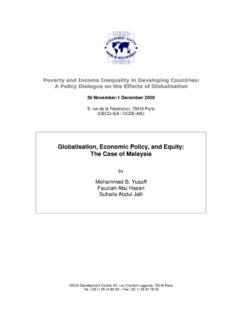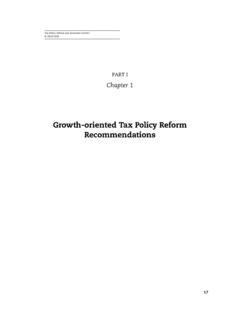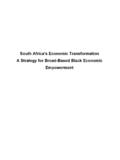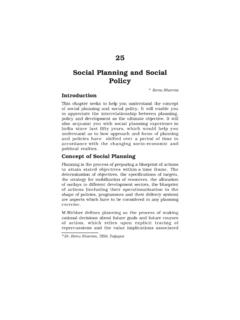Transcription of Inequality in Southern Africa
1 Inequality in Southern Africa : Options for Redress P o l i c y B r i e f Introduction and Background As a result, the SADC region can only be described as The Southern African region is characterised by a region in deep crisis. More than 60% of the population unacceptable high levels of unemployment, poverty in SADC lacks access to an adequate supply of safe water, and Inequality . In many cases, poverty and Inequality a third of the SADC population lives in abject poverty are on the increase, particularly in countries in crisis and about 40% of the labour force is unemployed or such as Zimbabwe and Swaziland.
2 Neither agricultural underemployed. Poverty levels have not only increased, economies such as Malawi nor resource-rich countries but have also become more pronounced in urban areas such as Namibia, South Africa and Angola have been and amongst female-headed households and the youth, able to significantly reduce wealth gaps and the rates of in particular. poverty and unemployment. When measured against the Human Development Most SADC countries managed to achieve some Index (HDI) - life expectancy, education and standards progress in the period immediately after independence, of living - seven SADC countries fall in the medium usually through expanded social services, to reach the category while six are in the low HDI group.
3 Although majority of the population which had been deliberately the majority of the countries fall within medium income neglected under colonial rule. However, there was no category the levels of income Inequality in the region systematic transformation of economic structures, and remain amongst the highest in the world (see table the typical African enclave economy persists until today. below). The distribution of resources and income This enclave economy which is typically characterised is highly skewed and in some cases racially biased, by a relatively small and well-resourced formal sector for example, in South Africa where white nationals that operates in isolation from a large, growing and constitute around 5% of the population and own over poverty-stricken informal economy and the communal 80% of the land.
4 Subsistence economy. Social mobility and equal opportunity remain alien concepts for far too many people in the region. There is 2 Traditional growth strategies are inadequate a close and direct relationship between Inequality and growth rates of 13% between 1970 and 1990 but could poverty, and thus any attempt to deal with poverty has not eradicate the high levels of poverty. What matters is to address the question of Inequality as well. Persistent not the quantity of growth but its quality. Currently, the gender inequalities in virtually all spheres of life from region's inherited structural legacies continue to shape, customary practices and labour market discrimination to produce and reproduce underdevelopment which has unequal access to social services and economic resources led to a deep developmental crisis.
5 Such as land are still a defining feature of Southern Africa . This is reflected, for example, in the gendered Southern Africa needs to break out of grafted impact of HIV/AIDS, which is still a major scourge in capitalism and enclave economy the region. Given the interlink between poverty, gender Southern Africa continues to experience the problems and HIV, it is hardly surprising that the epidemic has associated with its grafted capitalism . During hit black working class women and female peasants the colonialism, the region experienced a special type hardest.
6 This can only be altered through structural of social formation where the capitalist sector of interventions that will empower women to change their the economy was grafted onto a pre-capitalist form socio-economic status. HIV/AIDS cannot be treated of production in a distorted manner. This kind of as a medical problem but requires social and economic capitalism did not transform the economy as a whole changes. but only a small formal enclave sector, thus failing Widening disparities have increased the sense to produce dynamic growth and development.
7 This of injustice and deprivation for many as neither the small, formal enclave economy was totally dependent bureaucratic, state-centred, socialist form of government on external factors such as markets in, and capital in Angola nor the market-driven approaches of countries from Europe. This dependency is still visible today, like South Africa and Namibia were able to redress the as Mozambique, for example, depends for 50% of its colonial legacies of Inequality and exclusion. There national budget on donors while Lesotho, Malawi and is, thus, no doubt that Southern Africa needs a fresh Zambia rely on donors for 35 % of their annual budgets.
8 And different approach to address the current socio- Even Botswana received substantial donor support for economic crisis. its budget in 2010. Southern Africa 's enclave economies exist alongside Traditional growth strategies are inadequate an underdeveloped peasant-based subsistence rural The traditional strategies to foster growth as promoted economy and an urban informal economy. The formal by the IMF and World Bank, namely, macroeconomic sector consists of a small local and foreign business stability and market-friendly reforms, are evidently elite and wage workers, which usually account for less insufficient to meet the current challenges.
9 Instead, far than 20% of the labour force. This sector consists more emphasis needs to be placed on laying institutional of enterprises of various sizes (either state-owned or and social foundations for structural changes that will privately-owned) and is relatively productive compared facilitate a meaningful development process. to the other sectors. External forces such as Africa 's Most SADC governments are still trapped in the trading partners and foreign investors shape output and illusion that the private sector must be the engine for production methods.
10 Growth and the creator of wealth and development. The urban informal sector is characterised by easy Thus government's role in the economy is reduced entry and exit, linked to both formal and rural sectors to that of being a creator for conducive investment and driven by self-employment activities, dependent on conditions for private (usually foreign) capital. Such the ingenuity of individuals. It accommodates about supply-side interventions and market-driven approaches a third of the region's labour force. The communal to development are common in the region today.

















